
The Finnish Navy is one of the branches of the Finnish Defence Forces. The navy employs 2,300 people and about 4,300 conscripts are trained each year. Finnish Navy vessels are given the ship prefix "FNS", short for "Finnish Navy ship", but this is not used in Finnish-language contexts. The Finnish Navy also includes coastal forces and coastal artillery.

Landing craft are small and medium seagoing watercraft, such as boats and barges, used to convey a landing force from the sea to the shore during an amphibious assault. The term excludes landing ships, which are larger. Production of landing craft peaked during World War II, with a significant number of different designs produced in large quantities by the United Kingdom and United States.

A motor torpedo boat is a fast torpedo boat, especially of the mid 20th century. The motor in the designation originally referred to their use of petrol engines, typically marinised aircraft engines or their derivatives, which distinguished them from other naval craft of the era, including other torpedo boats, that used steam turbines or reciprocating steam engines. Later, diesel-powered torpedo boats appeared, in turn or retroactively referred to as "motor torpedo boats" for their internal combustion engines, as distinct from steam powered reciprocating or turbine propulsion.
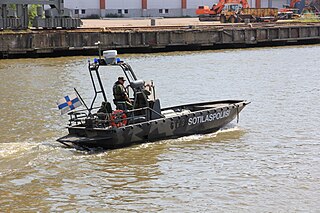
The G class, or "G-boat" also known as the Marine Alutech Watercat M8 landing craft is a type of vessel in use by the Finnish Navy and the Swedish Navy. The G-boat was originally designed for the Swedish Navy which ordered about 100 of them. It is primarily used for amphibious landings by, and transportation of, marines. It has a very low draught at high speeds which makes it ideal for amphibious assault even in shallow waters. It has a cargo capacity of 8 men or one metric ton.

A missile boat or missile cutter is a small, fast warship armed with anti-ship missiles. Being smaller than other warships such as destroyers and frigates, missile boats are popular with nations interested in forming a navy at lower cost. They are similar in concept to the torpedo boats of World War II; in fact, the first missile boats were modified torpedo boats with the torpedo tubes replaced by missile tubes.

Stridsbåt 90 H(alv) is a class of fast military assault craft used by several countries after being originally developed for the Swedish Navy by Dockstavarvet. Its name means Combat Boat 90 Half; the 90 refers to the year of acceptance (1990) and Half refers to the fact that it can carry and deploy a half platoon of amphibious infantry fully equipped. The CB90 is an exceptionally fast and agile boat that can execute extremely sharp turns at high speed, decelerate from top speed to a full stop in 2.5 boat lengths, and adjust both its pitch and roll angle while under way. Its lightweight, shallow draught, and twin water jets allow it to operate at speeds of up to 40 knots (74 km/h) in shallow coastal waters. The water jets are partially ducted, which, along with underwater control surfaces similar to a submarine's diving planes, gives the CB90 its manoeuvrability.

The Pacific class is a class of 22 patrol boats built by Australia and donated to twelve South Pacific countries. They were constructed between 1985 and 1997 and are operated by militaries, coast guards or police forces of twelve island nations. These boats are supported by the Pacific Patrol Boat Program and used primarily for maritime surveillance and fisheries protection.
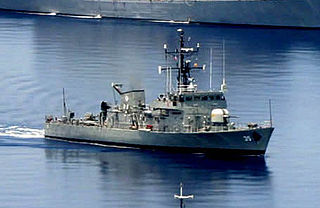
The BRP Emilio Jacinto (PS-35) is the lead ship of the Jacinto-class corvettes currently assigned to the Offshore Combat Force of the Philippine Fleet. She is one of few ships in the Philippine Navy equipped with modern systems after the completion of combat, navigation and weapon systems upgrade of her class in August 2019. She was originally called HMS Peacock (P239) during her service with the Royal Navy.
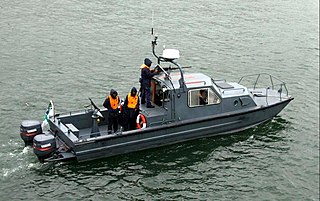
The Namacurra-class patrol boats are a series of small harbour patrol boats currently in service with South Africa, Namibia, Malawi and Mozambique.

ARM Durango (PO-151) is the first of four Durango-class patrol vessels in the Mexican Navy. Like other ships of this class, it was designed and built in Mexican dockyards. The ship is armed with a main 57 mm (2.2 in) gun turret and a helicopter landing pad. The vessel is primarily used for interdiction of drug smuggling. Launched and commissioned on 11 September 2000, Durango is currently in service.

The Japanese destroyer Nadakaze was one of 15 Minekaze-class destroyers built for the Imperial Japanese Navy (IJN) in the late 1920s. The ship was converted into a patrol boat in 1940 and then into a destroyer transport the next year. After the start of the Pacific War, she participated in the Philippines Campaign in late 1941, the Dutch East Indies campaign in early 1942 and played a minor role in the Battle of Midway in mid-1942. She was sunk by a British submarine in mid-1945.
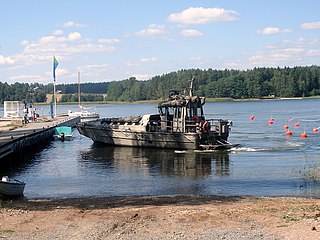
The Watercat M14 landing craft is a Jurmo-class type of military transport in use by the Royal Malaysia Police. The manufacturer is Marine Alutech Oy Ab, Finland. It is related to the Watercat M12 of the Finnish Navy.

The Korean People's Army Navy (KPANF; Korean: 조선인민군 해군; Hanja: 朝鮮人民軍 海軍; MR: Chosŏn-inmingun Haegun; lit. Korean People's Military Navy; or the Korean People's Navy, is the naval component of the Korean People's Army, the North Korean armed forces.

The Mark VI is a class of patrol boat for the United States Navy, designed to patrol riverine and littoral waters. The first two Mark VI boats were delivered to Coastal Riverine Group TWO in September 2015. Two boats were forward deployed to Bahrain in April 2016, with Coastal Riverine Squadron TWO being the first to operate the craft in the Persian Gulf while assigned under Task Force 56. The Mark VI replaced the less capable Riverine Command Boats previously assigned to Task Force 56.

The Swift-class coastal patrol craft were a series of patrol vessels built for the Republic of Singapore Navy (RSN) by the Singapore Ship Building and Engineering Company (SBEC).
The Saab Trackfire is a Remote Weapon Station (RWS), i.e. a remotely operated weaponized system that can be fitted with either medium or light caliber weapons. It can be mounted to vehicles, ships and stationary platforms. It is manufactured by Saab Group.
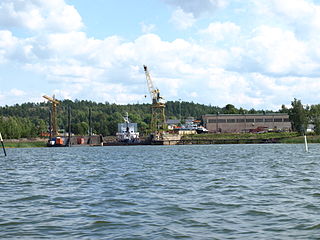
Marine Alutech is a leading designer and manufacturer of aluminium and composite boats in Finland. The company specializes in 5–27 meters boats and vessels for navies, coast guards, government agencies and port authorities. Marine Alutech has its own trading name Watercat.

Splinter fleet or Splinter navy was a nickname given to the United States wooden boats used in World War II. The boats served in many different roles during the war. These boats were built in small boatyards on the West coast and East coast, Great Lakes and the Gulf of Mexico. They could be built quickly, in just 60 to 120 days. Most of the boats were built by boatyards that already had the tools and knowledge from building yachts, sailboats and motor boats. Many were built by craftsmen in family-owned small businesses. Under the Emergency Shipbuilding Program and War Shipping Administration contracts went out to over fifty boatyards across the country. The boats were built for the US Navy, the United States Army Air Forces, United States Coast Guard, and US Army. Some of the wooden boats went to Allied nations on the Lend-Lease program.

Max Bernays is the third Harry DeWolf-class offshore patrol vessel for the Royal Canadian Navy. The class was derived from the Arctic Offshore Patrol Ship project as part of the National Shipbuilding Procurement Strategy and is primarily designed for the patrol and support of Canada's Arctic regions.



















